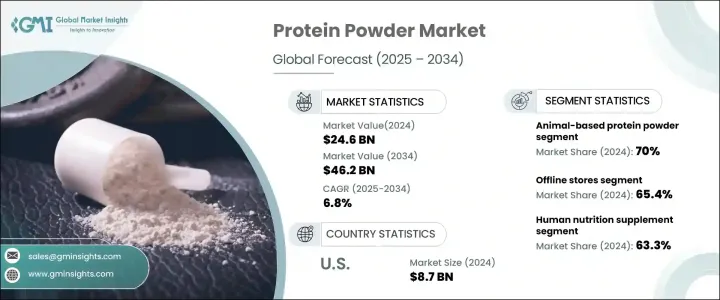
세계의 단백질 파우더 시장은 2024년에 246억 달러로 평가되었으며, 영양과 건강에 대한 소비자의 의식이 높아짐에 따라 2025년부터 2034년까지 연평균 복합 성장률(CAGR) 6.8%를 나타낼 것으로 예측됩니다.
이 급증은 고단백 음식에 대한 기호의 높아짐, 다양한 풍미의 이용가능성, 근육 개발, 대사 기능, 면역 지원에 있어서 단백질이 하는 중요한 역할에 뒷받침되고 있습니다.

예방 헬스케어에 대한 주목이 높아지는 가운데, 소비자는 건강 전반과 피트니스 목표를 서포트하는 제품을 요구하고 있습니다. 에 의해 운반에 편리한 영양 솔루션이 선호되게 되어, 시장의 확대를 한층 더 밀고 있습니다. 소비자는 식물 유래, 오가닉, 추가 영양소의 강화 등, 식생활의 기호에 따른 처방을 요구하고 있습니다.
| 시장 범위 | |
|---|---|
| 시작 연도 | 2024년 |
| 예측 연도 | 2025-2034년 |
| 시작 금액 | 246억 달러 |
| 예측 금액 | 462억 달러 |
| CAGR | 6.8% |
시장은 단백질 공급원별로 식물성 단백질 파우더와 동물성 단백질 파우더로 구분됩니다. 2024년 점유율은 70%로 시장을 독점했습니다. 유제품에서 추출한 유청 단백질과 카세인 단백질은 빠른 흡수와 근육 합성에 대한 입증된 효능으로 인해 이 부문을 계속 선도하고 있습니다. 한편 완두콩, 대두, 대마 단백질을 포함한 식물성 단백질 파우더는 소비자들이 비건 채식 및 알레르기 유발 물질이 없는 대안을 찾으면서 주목을 받고 있습니다.
단백질 파우더 시장의 유통 상황은 진화하고 있으며, 오프라인과 온라인 채널이 소비자의 구매 행동을 형성하고 있습니다. 하지만 그 원동력이 되고 있습니다. 슈퍼마켓, 영양 전문점, 건강 식품 소매점이 계속해서 주요 판매 채널이며, 소비자의 다양한 요구에 부응하는 다양한 제품을 제공합니다. 학을 재구성하고 있습니다. 현관까지의 배달이라는 편리성이, 온라인 한정의 할인이나 정기 구입 모델과 함께, 소비자의 구입 패턴에 변화를 촉진하고 있습니다. 디지털 쇼핑의 동향은 가속해, 브랜드는 타겟 광고, 인플루엔서 와의 제휴, 소셜 미디어 마케팅 전략을 통해, 온라인 프레즌스를 최적화할 필요에 강요되고 있습니다.
미국의 단백질 파우더 시장은 2024년에 87억 달러를 창출해 세계 업계 확대의 주요 지역이었습니다. 유통채널은 더욱 성장하는 태세가 갖추어져 있습니다. 디지털 판매 채널은 온라인 인게이지먼트 증가와 브랜드 주도의 마케팅 이니셔티브에 추진되어 비약적인 성장을 이루고 있습니다. 다수의 터치포인트를 통하여 적절하고 접근하기 쉬운 상품을 계속 제공합니다.
The Global Protein Powder Market, valued at USD 24.6 billion in 2024, is projected to expand at a CAGR of 6.8% from 2025 to 2034, driven by increasing consumer awareness of nutrition and wellness. This surge is fueled by a rising preference for high-protein diets, the availability of diverse flavors, and the crucial role protein plays in muscle development, metabolic function, and immune support. Health-conscious individuals and fitness enthusiasts are actively incorporating protein powders into their diets, reinforcing demand across various demographics.

With an increasing focus on preventive healthcare, consumers are seeking products that support overall well-being and fitness goals. The demand for protein powders is also being driven by a shift toward active lifestyles, where individuals prioritize dietary supplementation to enhance performance and recovery. Additionally, rapid urbanization and the fast-paced nature of modern living have led to a preference for convenient, on-the-go nutrition solutions, further propelling market expansion. Consumers are looking for formulations that align with their dietary preferences, whether plant-based, organic, or fortified with additional nutrients. As brands continue to innovate, new product launches catering to evolving consumer preferences are significantly influencing purchasing behavior.
| Market Scope | |
|---|---|
| Start Year | 2024 |
| Forecast Year | 2025-2034 |
| Start Value | $24.6 Billion |
| Forecast Value | $46.2 Billion |
| CAGR | 6.8% |
The market is segmented by protein source into plant-based and animal-based protein powders. Animal-based protein powders dominated the market with a 70% share in 2024, attributed to their superior amino acid profile and effectiveness in muscle recovery, weight management, and overall nutrition. These formulations are widely adopted by athletes, bodybuilders, and fitness professionals who require high-quality protein for optimized performance. Whey and casein proteins, derived from dairy sources, continue to lead the segment due to their rapid absorption and proven benefits in muscle synthesis. Meanwhile, plant-based protein powders, including pea, soy, and hemp protein, are gaining traction as consumers seek vegan and allergen-free alternatives. Brands are responding to this shift by enhancing product formulations to offer comparable protein content and improved digestibility.
The distribution landscape of the protein powder market is evolving, with offline and online channels shaping consumer purchasing behavior. In 2024, offline retail stores held a 65.4% market share, driven by consumer preference for in-store product trials and immediate purchases. Supermarkets, specialty nutrition stores, and health food retailers continue to be primary sales channels, offering a diverse range of products catering to different consumer needs. However, the growing influence of e-commerce platforms is reshaping the market dynamics. The convenience of doorstep delivery, coupled with exclusive online discounts and subscription models, has prompted a shift in consumer buying patterns. Digital shopping trends have accelerated, pushing brands to optimize their online presence through targeted advertising, influencer partnerships, and social media marketing strategies. Companies are leveraging data analytics to personalize offerings, enhance customer engagement, and drive sales in a competitive digital landscape.
The U.S. protein powder market, generating USD 8.7 billion in 2024, remains a key player in global industry expansion. With the number of licensed edible stores expected to surpass 165,000 in 2025, offline distribution channels are poised for further growth. Retailers are actively adapting to changing consumer preferences by improving product placement, expanding category selections, and offering in-store consultations to enhance customer experiences. At the same time, digital sales channels are witnessing exponential growth, fueled by increasing online engagement and brand-led marketing initiatives. Companies are continuously innovating to meet the dynamic expectations of modern consumers, ensuring product offerings remain relevant and accessible across multiple touchpoints. As the industry advances, competitive differentiation through product innovation, strategic partnerships, and omnichannel distribution will remain critical in sustaining market momentum.